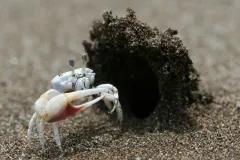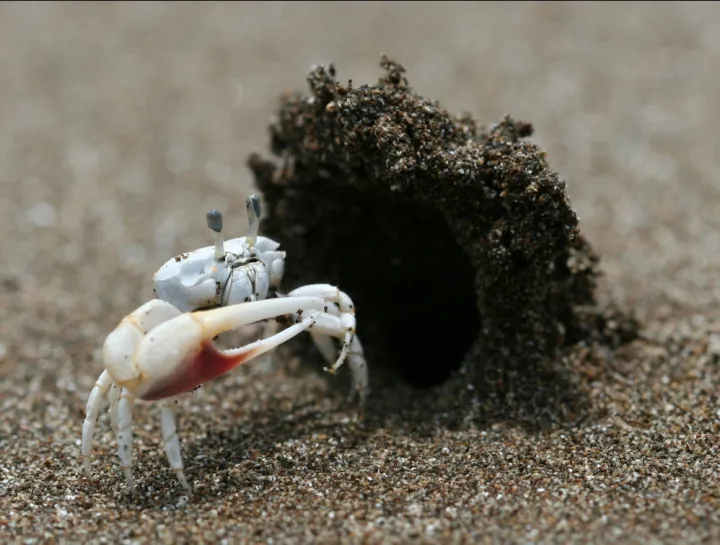The Design of a Beautiful Weapon

This summer, many of you have likely enjoyed feasting on crabs, be they blue, stone, or Dungeness, and a special treat will have been the big, easy morsels of claw meat. The size of this muscle is testament to its role in applying a forceful pinch to prey, predator, or competitor. But many crabs also use their lovely long claws to attract females—a function that does not depend on the power of the pinch. So which of these two uses was more important in driving the claw's evolution: its beauty or its strength?
Female fiddler crabs have two small claws that they use to pick up bits of sediment, from which they extract their microscopic food. Males have only one small claw; the other “major” claw is greatly enlarged and may constitute up to half the weight of an adult male crab. A male fiddler crab waves his major claw rhythmically to attract females and threaten other males, and also uses it to fight other males over burrows where crabs mate and breed.
Longer claws are easier to see, making them better for signaling than shorter ones. And the major claws of male fiddler crabs are very long: as long as the male’s body is wide, including the legs on both sides. But longer claws are not better for fighting because, like chopsticks, the forces produced at the tips of longer claws are relatively small. So how do the crabs manage to fight with such a long beautiful claw?
Using video recording and direct observation, my intern Stefan Dennenmoser and I found that fiddler crabs avoid the chopstick fight problem by pinching an opponent’s claw not with the tip, but with the tubercles (“teeth”) on the inside edge of their claw. As a male’s claw grows long and more attractive to females, these tubercles—like the cutting edge of needle-nose pliers—stay near the hinge of the claw where the male’s grip is strongest. In this way fiddler crab males grow a long, beautiful claw that also is an effective weapon.
But that is not the end of the story. As you can imagine, lighter claws are better for signaling females because males can wave them more vigorously and for longer compared to heavier claws. In contrast, heavier claws make better weapons because they better resist damage during fights. Working with Brook Swanson and students from Gonzaga University, we found that across 21 species of fiddler crabs, most claws are just heavy enough to resist being crushed in a fight. However, the males of some species have large, flashy claws that are relatively weak. The males of other species have powerful claws that are so heavy that they don’t work well for signaling to females. Now we are trying to discover the social and ecological factors that favor beauty over power in some species and vice versa.
So next time you bite into a delicious crab claw with friends or family, remind them that they are eating the result of millions of years of evolution, which, in species like fiddler crabs, is both very attractive to the opposite sex and a powerful weapon.


